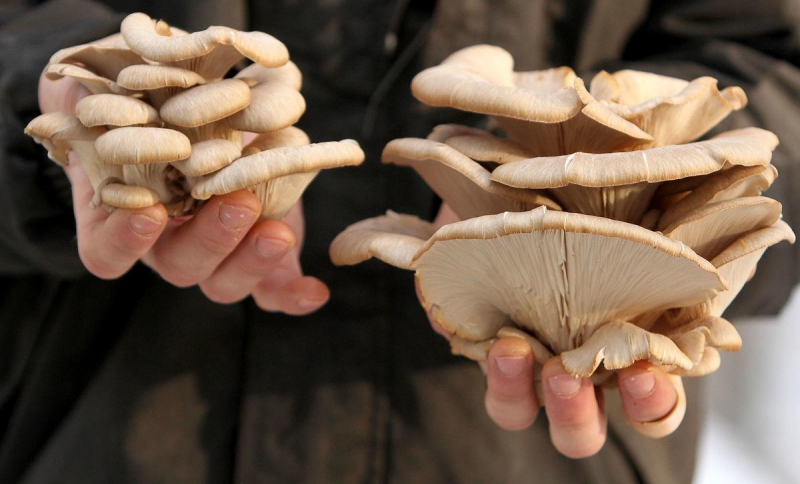
Been to an area farmers market lately? If so, you may have run across an abundance of mushrooms and one of their growers from Fiddlehead Knob, a fungus farm based in rural LeRoy, Minn.
Kalvin Stern and Rachel Davis run the farm together - Davis works another job, but Stern is a full-time farmer. Fiddlehead Knob produces mushrooms from the couple’s indoor grow room and outdoor log cultures, and is a staple at the Rochester and LeRoy Farmers Markets, as well as with a few area restaurants. Now that Stern is state-certified to sell foraged mushrooms as well, look for their stall to stock morel mushrooms and other tasty, wild varieties this spring.
Stern shares the challenges of cultivating mushrooms, flavorful spring and summer ‘shrooms, and the best ways to cook your farmers market haul.
What kinds of mushrooms are you growing now (in late April)?
Right now, we’ve got various different kinds of oyster mushrooms. We’ve got blue oysters, golden oysters, pink oysters, phoenix oysters, pearl, all sorts of different kinds of oysters. And then we also do outdoor shiitake logs, and those will be out this spring. … So we’ll have those throughout the spring, and the summer and fall as well. As I learn more, we hope to get into Lion’s Mane and some king oysters, which are a little different than regular oyster mushrooms. … All of those difficult-to-grow varieties. They’re a lot harder to find in the wild, and they’re ten times more delicious.
Will your stock change as summer approaches?
As we get warmer, I’m going to be doing a lot more outdoor stuff. I mentioned the pink oyster. That’s more of a tropical variety, so we don’t really do it in the winter because I’d have to heat the grow room up to 75, 80 degrees just to get it to fruit. And of course, it’s morel season. I hope to have those at the farmers market as well, since I’m certified to sell those. And again, shiitakes. The product that we’ve always had is our regular blue and phoenix oyster mushrooms. But those new oysters and the shiitakes are what we’re really excited about this summer.
Are you in Rochester every week?
We try to be. Mushrooms can be really finicky. I try to control everything I can and we grow them in a grow room, but sometimes - like, this week, I had a fan go out and that can alter a crop significantly. If I have a mushroom that’s two days into a fruiting cycle and a fan goes out overnight, that can totally dry them out and it ruins them. ... We’re learning stuff as we go, and different strains have different tendencies, based on the conditions I have in the grow room. It’s a huge learning process for us, but we’re figuring it out.
It’s weird to think of mushrooms as delicate, since they grow in the wild.
That’s the weird thing - when they grow in the woods, there’s obviously contaminants everywhere and things that can go wrong. I have a lab set up, and I have completely sterile conditions when I take a culture - whether it be from a spore or a tissue culture from the inside of the mushroom. I’m taking a certain mushroom that I thought performed well in my grow room, and then I clone that one … specifically for those conditions that I’ve set up. Anything that gets altered can just throw it out of whack.
What else are you excited about this spring?
We make tinctures with an alcohol extract that we’ll be selling. So reishi extracts, Turkey Tail, and Lion’s Mane. …We’ll have a medicinal line of products.
What are mushroom extracts useful for?
For anybody who’s curious about them, I encourage them to do their own research, because it can get kind of dicey when I say, “these help with this or that.” But there is a lot of information out there. Like, the reishi mushroom is an adaptogen, and I’ve taken it all winter long. I just put it in my coffee, 20 drops, and it has a lot of immune-boosting properties, so it can help you adapt if you get the flu virus coming at you. It can maybe help your body fight it off. Again, I encourage everyone to do their own research and check with their own doctor.
Do you have tips for preparing and eating the mushrooms you sell?
For the cooking of these more gourmet mushrooms, not your typical portobello or white button mushrooms, you can use them in a lot of ways. The oyster mushrooms, they’re going to have much more flavor than a button mushrooms. I typically have them with my eggs every morning. But we also do pizzas with them, and we eat a lot of Indian food, so we’ll make tikka masala with oyster mushrooms or a shiitake, or chicken-of-the-woods or hen-of-the-woods, which are wild mushrooms. … You can put them in pasta, a stir fry, they’re really good in that.
























